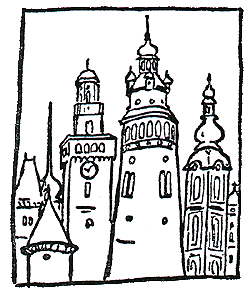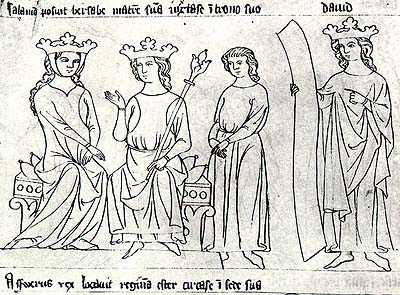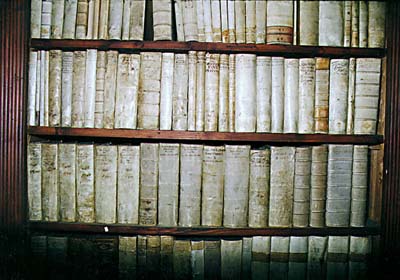Český Krumlov in Literature
The beginnings of literary traditions in Český Krumlov go back
to the 14th century and they are very closely connected with the
high educated court of the Rosenbergs and with ecclesiastical
institutions that influenced the life of the town. These were
especially the Minorite monastery and Clare nuns´ monastery
established in 1350 and the parish church of St. Vitus. The
curate's library existed at this church from 1380. The whole
cultural standard of Český Krumlov was influenced as well with a
school which was founded in the last third of the 14th century.
 As
a result of the rising ambition of the Rosenbergs to reach a level
of the Prague royal court, we can distinguish a rising significance
of literary culture in Český Krumlov. The Rosenbergs were very
important buyers of many manuscripts written especially for their
court or for churches and monasteries in the town. An inception of
the so-called Book of the Rosenbergs is connected with this
aristocracy family. This book is one of the most significant
memoirs of old Czech legal prose.
As
a result of the rising ambition of the Rosenbergs to reach a level
of the Prague royal court, we can distinguish a rising significance
of literary culture in Český Krumlov. The Rosenbergs were very
important buyers of many manuscripts written especially for their
court or for churches and monasteries in the town. An inception of
the so-called Book of the Rosenbergs is connected with this
aristocracy family. This book is one of the most significant
memoirs of old Czech legal prose.
A famous pictorial almanac called Liber depictus dates from the middle of the 14th century and is now placed in the National Library in Vienna. This codex, probably brought to the new Minorite monastery by its monks, contains many pictures with texts from the Bible and legends about saints. It was known as the poor man's bible, but the expression of poorness in this context does not express a lack of money but rather a lack of education. The painting decorations of this almanac very significantly influenced mural painting of those times.
Another important book was probably ordered for the monastery of the Clare nuns - Český Krumlov Memorial Volume dated around 1420. It is placed in the National Library in Prague today. Eliška z Kravař, a wife of Henrich III. von Rosenberg is alleged to be its buyer. The book is written in the Czech language and contains theological, moralising and mystical texts.

|

|
During the Hussite wars, the cultural continuity in Český Krumlov was not forcely interrupted from the pre-Hussite period as had happened in the rest of Bohemia, due to the fact that Ulrich II. von Rosenberg (1403 - 1462) was the head of the Catholic aristocracy. Many church dignitaries, aristocrats and artists who contributed to the cultural development of Český Krumlov came to the town in these dangerous times. In the second half of the 15th century the influences of humanism slowly began to influence Český Krumlov, especially due to the visits of the Rosenbergs and many aristocrats to universities in Italy. A very distinguished personality of those times was Václav z Rovného, a chancellor of the Rosenbergs who surrounded himself with well educated men orientated in humanism and coming from the wealthy citizenry and clergy. The chancellor also had a very large library that has been partly preserved until today, and he himself continued writing with the humanist Filip Beroald Sr. from Bologna.
 The Renaissance came to
Český Krumlov during the time of the last Rosenbergs. Wilhelm and
Peter Wok von Rosenberg continued to build up the Castle
Library in Český Krumlov which had played a very important role
in the pre-Hussite period. Peter Wok von
Rosenberg extended the funds of this library up to 11 000
volumes, which in those times was quite unique in Central Europe.
But later the books came into the collections of Rudolf II and they
were stolen by the Swedish army during the Thirty Years War. A
register of this library was written by a archivist of the
Rosenbergs Václav
Březan who was known as a writer of the History of the
Rosenbergs.
The Renaissance came to
Český Krumlov during the time of the last Rosenbergs. Wilhelm and
Peter Wok von Rosenberg continued to build up the Castle
Library in Český Krumlov which had played a very important role
in the pre-Hussite period. Peter Wok von
Rosenberg extended the funds of this library up to 11 000
volumes, which in those times was quite unique in Central Europe.
But later the books came into the collections of Rudolf II and they
were stolen by the Swedish army during the Thirty Years War. A
register of this library was written by a archivist of the
Rosenbergs Václav
Březan who was known as a writer of the History of the
Rosenbergs.
Also the Jesuit college (Horní No. 154) contributed to the cultural development of Český Krumlov. This college was established by Wilhelm von Rosenberg in 1584. Because the Jesuits were very active in pedagogical and preaching activities they also had a rich and continually expanding library (see History of the Jesuit Library in Český Krumlov). Also the very famous Baroque writer and historian Bohuslav Balbín lived in this college in 1664 - 1665. In the 17th century the prelate library was extended. The credit in this library is due to the prelate of Český Krumlov Jiří Bílek from Bílenberk who was famous for his defense of the Czech language. The Baroque period was also a time of building large libraries in castles. These libraries were established not just for the use of their owners but also for representative purposes. The Eggenbergs collected a large number of books that can tell us very much about the level of their literary interests. Among them were many books with secular and ecclesiastical themes, mostly printed in the Romantic languages. The Schwarzenbergs, who inherited the whole estates of Český Krumlov from the Eggenbergs in 1719, also continued building up the library. But we cannot forget the importance of the town libraries and literature which was dedicated to common people, such as hymn books, prayer books and many other moralising or popular books.
From the end of the 18th century Český Krumlov began to be a provincial town which took part in the very slow and inexpressive development of industry in the region as well as with the Schwarzenbergs' orientation in their residence in Hluboká nad Vltavou. The noble family began to prefer this residence to the Český Krumlov castle. In the 19th and 20th centuries no significant actively writing personality appears in Český Krumlov. But Český Krumlov itself as a town with a very rich history, many memories and atmosphere contributed to the literary inspiration of a number of famous writers, such as Eliška Krásnohorská, Karel Čapek and František Hrubín who wrote a beautiful rendition of The Beauty and the Beast for the revolving stage open-air theatre situated in the castle garden. Other writers mostly wrote about the Rosenberg family. This theme was treated in novels or poems by for example Jaroslav Vrchlický, Alois Jirásek, František Kožík, Nina Bonhardová, Josef Mařánek and many others. A specific literary type is formed by the Legends and Tales of Český Krumlov written by Radovan Krátký, Stanislav Cífka or Helena Braunová. During the 19th century and especially after 1920 chronicles writing about significant events in Český Krumlov also were published (see Town Chronicles of Český Krumlov).
Several considerable literary personages visited Český Krumlov and the impressions of these visits appeared in their work:
"...Krumlov, the loveliest position. A view of the castle, town and countryside from the West to the East. The Vltava river. On the vertical bank little houses, churches sitting closely up to the rock; finally rocks behind the river. Towards midnight the old, beautiful preserved castle on the solid rock. A new building on the bridge on the pillars, the bridge, statues. An old part of the castle, the recess of a balcony, a little roof in the angle of a chapel over the semicircle rock. Again the part of the old castle, the windows; the white portraits between them. An old round very tall tower. Double windows, an arcade, a clock to four sides, then statues. A park on the rock from the West, mountains behind, high blue mountains to the left in the distance. The town shone white."
Karel Hynek Mácha, Diary, A Trip to Italy - August 1834
"...Krumlov is the absolute of its kind which finally subdues, with its recollected charms, those who otherwise focus their interest only on the topical events of the present, refusing any return as an old lovers' nostalgia. For Krumlov the history is still alive, it is a monumental bridge over the ages in the true sense of the word, it is a colossal span in itself from the unknown depths of the past through today, up to the nebula of the faraway future."
Jiří Mařánek
"...I do not know how many times the Vltava meanders before you get through the town - doing so as directly as possible you will cross it about five times and each time you are surprised that it is so golden-brown and in a hurry. Neither do I know how many inhabitants Krumlov has, but there are twenty-four pubs, three churches, one castle, still two large town gates and a large number of monuments; in fact the whole town is one big historic monument which reminds one of Sienna or Stirling or other famous places. Well, there are old gables, bays, dormers, arcades, archs, galleries, battlements, sgrafitto, frescoes, stairs up and down, balustrades, fountaines, columns, corner stones, nooks, frame-works, maßhaus, underpasses, historic pavement, zig-zagging lanes, Bethlehems, high roofs, a Gothic church, Minorites and all over the place the red roses of the Rosenbergs, everywhere you stir you can see only picturesqueness and antiquity and historical fame, while in the old suburbs there are only low houses whose roofs you can touch with your hand, geraniums in the windows and the sign over the door, here old crafts are still alive as in the fifteenth century.
Everything is dominated (and really so after the Dukes of Eggenberg) by the castle over there and particularly the tower, one of the most towery towers which I have ever seen, I would say that towers are a Czech speciality because nowhere else can you find such strange cupolas, paunchy onion-domes, poppy-head cupolas, lanterns, stuck little turrets and galleries and spires as in this country; each old Bohemian town has its own particular tower by which you can tell that this is Hradec and this is Brno and this is Budějovice and this is Český Krumlov.
 As concerns the castle,
it is all decorated and covered with frescos inside as well as
outside but the best of all is the little Baroque theater in which
the old decorations still hang; an eighteenth century Italian opera
could haunt this place at this moment but it does not because it is
not allowed to perform here because of safety measures. Further
there is the summer-house Bellarie with such funny stairs on the
facade and lots of other Baroque things; for three crowns this is
enough and to spare..."
As concerns the castle,
it is all decorated and covered with frescos inside as well as
outside but the best of all is the little Baroque theater in which
the old decorations still hang; an eighteenth century Italian opera
could haunt this place at this moment but it does not because it is
not allowed to perform here because of safety measures. Further
there is the summer-house Bellarie with such funny stairs on the
facade and lots of other Baroque things; for three crowns this is
enough and to spare..."
Karel Čapek, Pictures from Home





